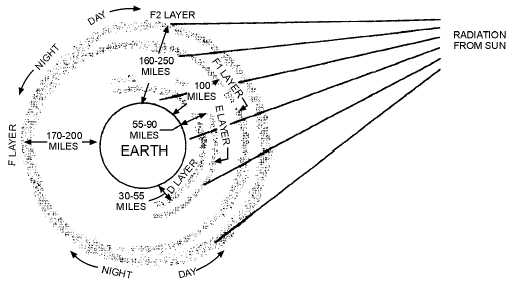2-20
Figure 2-14.—Layers of the ionosphere.
a. The D layer ranges from about 30 to 55 miles. Ionization in the D layer is low because it is the
lowest region of the ionosphere. This layer has the ability to refract signals of low frequencies.
High frequencies pass right through it and are attenuated. After sunset, the D layer disappears
because of the rapid recombination of ions.
b. The E layer limits are from about 55 to 90 miles. This layer is also known as the Kennelly-
Heaviside layer, because these two men were the first to propose its existence. The rate of ionic
recombination in this layer is rather rapid after sunset and the layer is almost gone by midnight.
This layer has the ability to refract signals as high as 20 megahertz. For this reason, it is valuable
for communications in ranges up to about 1500 miles.
c. The F layer exists from about 90 to 240 miles. During the daylight hours, the F layer separates
into two layers, the F1 and F2 layers. The ionization level in these layers is quite high and varies
widely during the day. At noon, this portion of the atmosphere is closest to the sun and the degree
of ionization is maximum. Since the atmosphere is rarefied at these heights, recombination occurs
slowly after sunset. Therefore, a fairly constant ionized layer is always present. The F layers are
responsible for high-frequency, long distance transmission.
Q17. What causes ionization to occur in the ionosphere?
Q18. How are the four distinct layers of the ionosphere designated?
Q19. What is the height of the individual layers of the ionosphere?
REFRACTION IN THE IONOSPHERE
When a radio wave is transmitted into an ionized layer, refraction, or bending of the wave, occurs.
As we discussed earlier, refraction is caused by an abrupt change in the velocity of the upper part of a
radio wave as it strikes or enters a new medium. The amount of refraction that occurs depends on three
main factors: (1) the density of ionization of the layer, (2) the frequency of the radio wave, and (3) the
angle at which the wave enters the layer.

